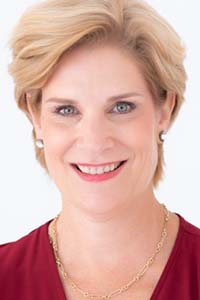
Women in or seeking leadership roles women are faced with barriers and trade-offs that their male counterparts don’t often experience.
How can the business events community celebrate the qualities that make female leaders effective? What can we do to overcome the barriers to the advancement of women into leadership roles?

Karen Calder
Come explore the answers to these questions at today’s session, Elevating Women in Business Events: Removing Barriers and Creating Opportunities This interactive session will be led by Karen Calder, founder of Karen Calder Consulting & Coaching, who opened up her notebook to share her thinking behind this session. Have a look at her notes:
We know that leading as a woman has its many challenges and there are differences between the way women lead their teams compared to their male counterparts.
Women face systemic obstacles like gender bias, but they also feel compelled to live up to the expectation of balancing it all — having a career, often being the primary caregiver for their families, while looking after their own health and wellbeing. This means women are faced with barriers and trade-offs that our male counterparts don’t often experience. And yet, despite these challenges, many women excel as leaders. Unfortunately, while there have been efforts to develop female leaders for decades, women continue to be vastly underrepresented at senior levels of leadership — and that seems true for the business events industry as well.
IBM and Chief’s latest study, Women in Leadership: Why Perception Outpaces the Pipeline — and What to Do About It, shows that the pipeline for top leadership positions still hasn’t recovered to pre-pandemic levels, and has reduced to just 14-percent and 18-percent female representation at the SVP and VP levels respectively. “Advancing women in leadership is not a formal business priority for the majority of organizations surveyed,” according to the study of 2,500 executives, managers, and professionals, equally split between men and women, from organizations in 12 countries and across 10 industries. But, the report adds, “there is a roadmap for sustainable progress.”
Survey respondents estimate their industry will see gender parity in leadership in 10 years, compared to 2019 when the average industry estimate was 54 years. But the reality is, at the current rate of change based on survey data, gender parity is still decades away. That is because:
- Structural barriers and unconscious bias continue to hinder women’s advancement. For example, when asked if women with dependent children are as dedicated to their jobs as women without children, the majority of respondents said yes, this is what leaders in their organization believe, with the exception of male managers — only about 40 percent agreed.
- The attributes perceived as critical for leadership also remain gendered. Respondents shared men are primarily valued for creativity and being results-oriented while women are expected to be strategic and bold but also people-oriented.
- The pandemic continues to have a disproportionate impact on women at work. Respondents rank the pandemic as the most serious disruption facing women in their career progression.
What Makes Female Leaders Stand out?
Today’s session also will offer a sneak peek of the initial findings of a global research study conducted by BESydney and PCMA. Some of the key characteristics the study, which included think tanks, has uncovered about the differences between male and female leaders are:
A Strong Sense of Self-Worth — Women commented in the think tanks about having lower self-esteem than their male counterparts, which has a negative effect on self-advocating for promotions. In addition to all the other barriers, women’s mindset and self-doubt — believing that others have answers and abilities they don’t possess — keep them back.
Setting Personal Goals — Successful women in our Think Tanks spoke about having a clear vision for their careers and setting goals for what they want to achieve early on in their career — they didn’t wait until after having a family. They spoke about aspects of their vision changing over the years due to circumstances, but the commitment to reaching their north star remained unwavering.
Asking for Help, Mentorship, and Being a Sponge — Women in the study were more likely to reach out and ask for help. Many of them talked about the importance of mentorship and networking, about learning to understand the limitations of trying to do everything yourself and feeling empowered to seek insights, feedback, and knowledge from successful leaders.
Getting on a Leadership Path
Learn more about the traits that can set women on a leadership path during today’s session. In the meantime, here’s Calder’s tip sheet:
- Identify what you are good at and play to your strengths.
- Set clear goals.
- Take risks.
- Develop an unstoppable mindset. Be your own champion.
- Build a resilient mindset.
- Don’t compare yourself to others.
- Learn to be a good presenter, storyteller, and promoter.
- Get a sponsor/mentor.
- Volunteer for growth assignments.
- Take opportunities that come your way and treat them as learning opportunities.
- Learn about trailblazing women.
- Listen to something positive for 20 minutes every day.
- Be supportive of other women.
- Take care of yourself.
